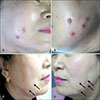This article has been
cited by other articles in ScienceCentral.
Dear Editor:
A 68-year-old female patient visited our clinic with severe painful and itching skin lesion around chins three months ago. On the physical examination, several erythematous to brownish round shaped papules and nodules were observed (
Fig. 1A, B). She had received botulinum toxin injection on both jaws illegally elsewhere 7 months previously, not by a medical doctor. Foreign body granuloma, furuncle, and cutaneous tuberculosis (TB) were clinically suspected and a punch biopsy was performed. Upon histopathologic examination, inflammatory cell infiltration and granulomatous inflammation were observed in the dermis (
Fig. 2A). Acid fast bacilli stain was negative. Initially, both
Mycobacterium tuberculosis (MTB) and non-tuberculous mycobacteria (NTM) were negative in polymerase chain reaction (PCR).
In order to rule out the possibility of TB infection, TB-specific Ag induced IFN-gamma testing was performed. The result was positive and the patient was sent to the pulmonary medicine department but pulmonary TB was not suspected by chest high resolution computed tomography. Then, re-biopsy was subsequently performed to exclude cutaneous TB or NTM. From the histopathologic examination at re-biopsy, MTB-PCR was negative, but NTM-PCR was positive (
Fig. 2B). Finally, the patient was diagnosed with cutaneous NTM. The microorganism was not detected in the test for identification of the microorganism. The patient was subsequently treated with clarithromycin and levofloxacin, and large lesions on both cheeks were surgically excised. After two months of treatment, lesions were significantly improved (
Fig. 1C, D). We received the patient's consent form about publishing all photographic materials.
NTM refers to mycobacterium except for MTB and leprosy bacteria
1. Although cutaneous NTM is rare, the incidence is increasing due to advances in diagnostic methods such as PCR and increased invasive cosmetic procedures
234. Typical skin lesion is erythematous nodule, but clinical presentation may be variable including ulcers and abscess
2. Identification of mycobacterium species from cultures of skin biopsies is the standard diagnostic method. PCR and DNA sequencing can be used to identify the exact subtypes
5. The histologic findings may be present in various forms, such as abscess, necrosis, granuloma, and inflammatory cells infiltration
1. Treatments regimens are not well established. Tetracyclines, macrolides, quinolones, and co-trimoxazoles are the most commonly used drugs
24. In our case, we initially suspected skin TB infection due to the history of illegal botulinum toxin injection, but the result of PCR was negative from the initial biopsy specimen. However, re-biopsy was performed based on the clinical feature and patient's history of illegal cosmetic procedure. NTM-PCR was positive in the re-biopsy specimen and eventually diagnosis of cutaneous NTM was established. Due to the trend that the prevalence of cutaneous NTM is increasing because of the illegal cosmetic procedure, the possibility of NTM infection should be considered for skin lesion that does not respond to initial treatment at the site of invasive procedures. It is helpful to perform culture and biopsy repeatedly if necessary, as we were able to successfully diagnose NTM through repeated biopsy. In this context, we report a case of cutaneous NTM that may serve as a useful educational case.
Figures and Tables
Fig. 1
(A, B) Several erythematous to brownish round shaped papules and nodules were observed on both cheeks. (A) Right cheek, (B) Left cheek. The large lesions were surgically removed via punch biopsies. The removed sites are indicated by arrows. (C, D) After treatment of two months, the lesions were improved. (C) Right cheek, (D) Left cheek.

Fig. 2
(A) In the histology of the first biopsy, inflammatory cells infiltration and granulomatous inflammation was observed in the dermis (H&E, ×40). (B) From the histopathologic examination at second biopsy, NTM-PCR was positive. NTM: non-tuberculous mycobacteria, PCR: polymerase chain reaction, M: size marker, Pc: positive control, N: negative control.

ACKNOWLEDGMENT
This study was supported by grants of the National Research Foundation of Korea (NRF), funded by the Ministry of Science, ICT & Future Planning (NRF-2017R1A2B4006252), Korea Healthcare technology R&D project, funded by Ministry of Health & Welfare, Republic of Korea (HI17C0597), and the Hallym University Research Fund (HURF-2017-35, HURF-2017-52, HURF-2017-83).
References
1. Byun YS, Son JH, Cho YS, Yang YS, Cho HJ, Chung BY, et al. Cutaneous mixed infection of mycobacterium fortuitum and mycobacterium intracellulare after a fat graft. Korean J Dermatol. 2016; 54:459–463.
2. Lamb RC, Dawn G. Cutaneous non-tuberculous mycobacterial infections. Int J Dermatol. 2014; 53:1197–1204.


5. Ngan GJ, Ng LM, Jureen R, Lin RT, Teo JW. Development of multiplex PCR assays based on the 16S-23S rRNA internal transcribed spacer for the detection of clinically relevant nontuberculous mycobacteria. Lett Appl Microbiol. 2011; 52:546–554.








 PDF
PDF ePub
ePub Citation
Citation Print
Print



 XML Download
XML Download